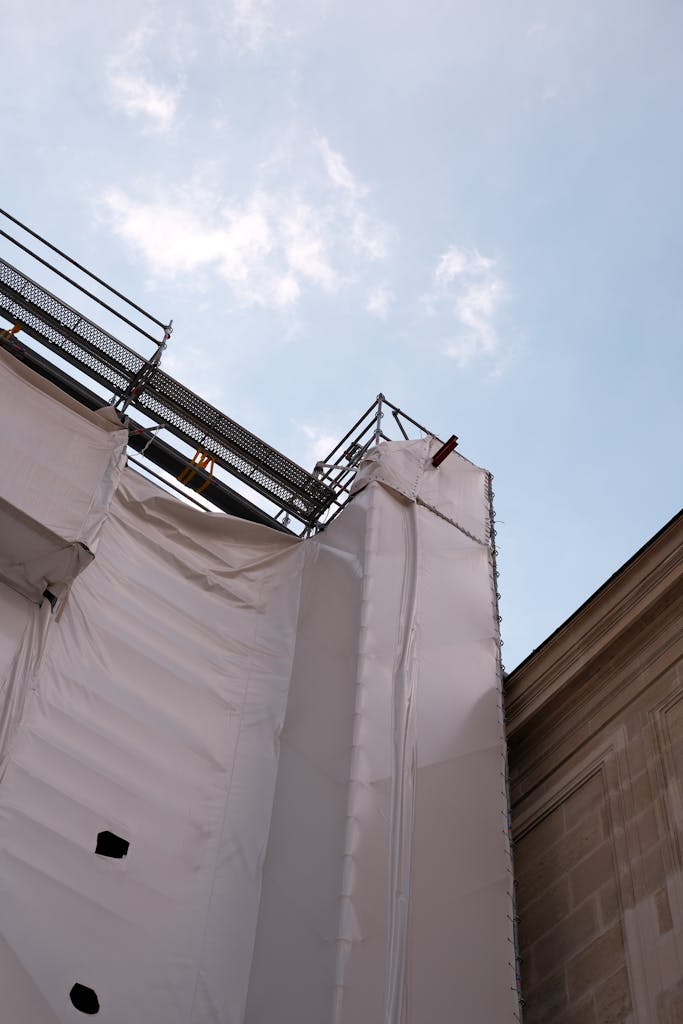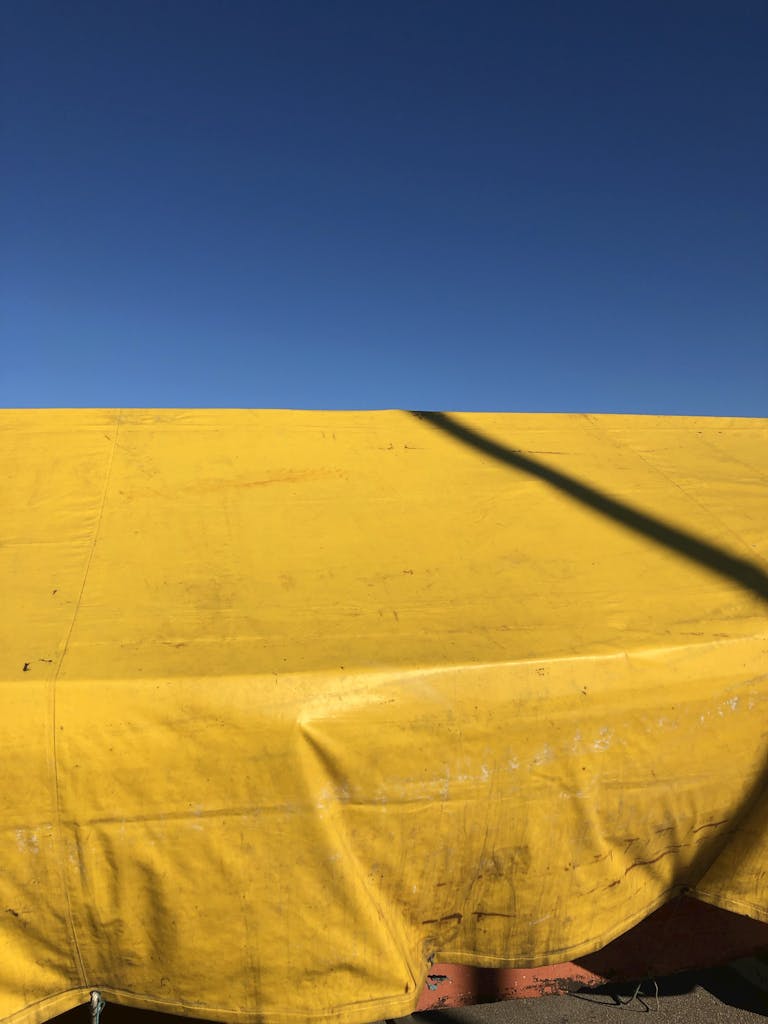Tarpaulin When to use: 7 Surprising Situations
Introduction
A tarpaulin, or tarp as it’s commonly known, is a strong, flexible fabric known for its ability to resist water. It’s usually made from materials like canvas, polyester, polyethylene, or polyurethane plastics. Its main purpose? To protect. Whether it’s keeping things safe from bad weather or covering areas to prevent unwanted dirt, a tarpaulin is a very useful tool in many situations.
Tarpaulins might seem simple at first. But they can do more than just cover things or cover construction sites. The key word here is adaptability. Tarps can be surprisingly helpful in different ways that you might not expect.
In this article, we will talk about when to use tarpaulin besides its usual uses. We will look at seven surprising situations where tarps can be the answer to your problem. With each situation, you’ll see how this simple fabric can change itself to fit different needs and problems.
By the end of this article, you’ll understand more about how useful tarps can be in different situations and maybe even get some ideas for your own life. So let’s start looking at the interesting sides of tarps!
Protecting Cargo during Transportation
When you’re transporting goods, especially over long distances or through unpredictable weather, the safety and integrity of the cargo are paramount. This is where tarpaulins come into play, providing robust protection for goods in transit. If you’ve ever seen flatbed trucks on the highway with their loads covered by large, sturdy sheets, you’ve witnessed tarpaulin for cargo protection in action.
Tarpaulins’ Role in Cargo Safety
- Shield Against Elements: Transporting goods in open vehicles like trucks exposes them to natural elements. Tarpaulins act as a barrier against rain, wind, sun, and debris.
- Prevention of Loss: High-speed travel can cause lighter items to displace or fall off the vehicle. A secured tarp can prevent this from happening.
- Theft Deterrence: Concealing cargo under tarps can also deter potential thieves since the contents are not readily visible or accessible.
- Compliance with Regulations: Many regions have laws that require cargo to be properly covered during transport to prevent road hazards.
Expert Insights
A logistics expert emphasizes the importance of using quality tarpaulins:
“In logistics, delivering goods in pristine condition is not just a goal; it’s a necessity for maintaining trust and business continuity. Using high-grade truck tarps such as the 140 GSM Green/Silver Super Tarpaulin from EIRCOVER is one of the simplest yet most effective strategies to ensure cargo reaches its destination without damage from environmental factors or pilferage.”
Selecting the Right Tarpaulin
When choosing a tarpaulin for cargo protection, consider:
- Material: Polyethylene tarps like the 140 GSM Green/Silver Super Tarpaulin are durable and offer excellent protection.
- Size: Ensure the tarp is sufficiently large to cover your entire load without leaving any parts exposed.
- Durability: Look for features such as aluminium eyelets and reinforced corners for secure fastening.
By selecting an appropriate tarp and using it correctly, you safeguard your cargo against common transport risks.
2. Construction Site Enclosure and Safety
When it comes to choosing tarpaulin for construction sites, it’s clear that these versatile sheets serve more than just one purpose. Notably, they are pivotal in creating enclosures which leads to multiple benefits:
Benefits of Using Tarpaulin for Construction Site Enclosure
- Preventing unauthorized access: Tarpaulins act as a barrier, signaling to passersby that a construction area is off-limits. This is critical for safety and security, ensuring that only personnel with proper clearance enter the site.
- Safeguarding workers: Construction sites are exposed to the elements—be it rain, wind, or harsh sunlight. Tarps provide a shield, improving work conditions and helping to prevent weather-related delays.
Building Protection with Tarps
Building protection is another area where tarps show their true colors. They cover exposed areas effectively, preventing water damage that can otherwise lead to costly repairs or structural issues. Additionally, they contain dust and debris, especially during demolition or renovation projects, ensuring pollutants do not spread into neighboring areas.
“Implementing tarpaulin solutions at our construction sites has been a game-changer,” says Alex Turner, a seasoned construction manager. “They are quick to deploy and incredibly effective at protecting building materials from the weather. Plus, they help us comply with safety regulations by keeping the public out of hazardous areas.”
For building protection purposes, consider the following applications of tarps:
- Temporary roofs and overhead coverings keep interiors dry during roofing projects or unexpected weather events.
- Sidewall covers protect the sides of structures when permanent walls are not yet erected.
- Groundsheets prevent ground moisture from compromising building materials or equipment stored on-site.
Choosing the Right Tarp for Your Construction Site
Should you require robust tarpaulins that stand up to the rigors of construction work, products like the 185 GSM Brown/Blue Tarpaulin 6 x 11m offer durability and reliability. This particular tarp comes equipped with features suited for heavy-duty applications:
- 12mm aluminum eyelets spaced at 50cm intervals for secure anchoring
- Reinforced hems and sturdy 3-rivet reinforcements at each corner for added strength
- UV inhibitor coating to withstand sun exposure
Selecting a high-quality tarp like this ensures longevity and effectiveness in safeguarding your construction site against various environmental challenges.
3. Emergency Shelter and Relief Efforts
When disaster strikes, tarpaulins play an irreplaceable role in providing quick, efficient, and flexible solutions for affected communities. Their use extends far beyond just covering cargo or construction sites – they become a beacon of hope in the form of temporary shelter for displaced individuals during natural disasters or humanitarian crises.
The Importance of Tarpaulins in Emergency Situations
As you might already know, tarpaulins are renowned for their durability and resistance to adverse weather conditions. These qualities make them an ideal choice for emergency shelter provisions in the aftermath of catastrophes such as earthquakes, floods, or war conflicts. The material can be quickly assembled into makeshift homes, providing a safe haven from external elements for families that have lost their dwellings.
The Versatility of Tarps in Disaster Recovery
But the utility of tarps in disaster recovery doesn’t stop at housing. They also serve other crucial roles depending on the needs of the situation at hand:
- Improvised Medical Facilities: They can be used to create improvised medical facilities. In scenarios where hospitals are overrun or non-existent, health workers can utilize tarps to establish temporary clinics or field hospitals. This helps ensure that medical care remains accessible even amidst chaos.
- Communal Spaces: Tarps can also act as communal spaces for affected communities to gather. It could be a makeshift school under a large tarpaulin canopy or a common area where relief goods are distributed. These communal tarps provide a sense of normalcy and community coherence in otherwise challenging times.
A Real-Life Example: ShelterBox
One organization that exemplifies the effective use of tarpaulins in disaster recovery is ShelterBox. This non-profit specializes in delivering emergency shelter kits worldwide whenever disasters occur. Each kit includes a high-quality tarpaulin, along with other essential tools like ropes, nails, and hammers. These kits have been deployed in numerous disaster-stricken areas globally, helping thousands rebuild their lives post-crisis.
The Right Tarp for the Job
In essence, tarpaulins prove to be a versatile and practical solution in times of emergency. However, it’s important to remember that not all tarps are created equal. For instance, the 310 GSM Clear PVC Tarpaulin from EIRCOVER is specifically designed to withstand harsh weather conditions, making it an excellent choice for disaster recovery situations.
4. Versatile Tool for Outdoor Enthusiasts
Tarpaulin for camping and hiking gear is not just an add-on; it’s a non-negotiable essential for many outdoor enthusiasts. When you’re out in the wilderness, a high-quality tarp can be the difference between comfort and misery. Tarpaulins are lauded for their versatility, performing a variety of functions that go beyond simple rain protection.
Why Tarps Are Crucial for Outdoor Activities
Here are some reasons why tarps are crucial for outdoor activities:
- Rain Protection: A tarp will shield you from downpours, whether strung up between trees or placed atop a tent as an extra layer.
- Improvised Tents: With some ropes and stakes, a tarp transforms into a makeshift shelter, saving weight and space compared to traditional tents.
- Ground Covers: Placed under tents, tarps protect the base from abrasion and punctures while keeping moisture at bay.
An experienced hiker shared their perspective on this matter:
“I’ve faced all kinds of weather on the trail, and my tarp has never let me down. It’s my makeshift tent when I want to sleep under the stars but need protection from dew or bugs. It’s my emergency poncho during unexpected showers. And it’s my picnic blanket when I find that perfect spot by the river. For me, hitting the trail without my trusty tarp is like leaving without my compass – unthinkable.”
Best Tarpaulin Options for Outdoor Use
For those who are looking to invest in robust gear, consider options such as the 270 GSM Heavy Duty – Black / Silver Tarpaulins 3 x 6 m from EIRCOVER. Designed for longevity yet lightweight enough for easy transportation, these tarps stand up to rough weather conditions without succumbing to tears or cracks due to cold temperatures.
The Importance of Adaptability in the Outdoors
The adaptability of tarpaulins makes them integral to outdoor adventures. Whether you’re setting up camp in the forest or resting after a long hike, your tarp serves as a multi-purpose tool that adapts to your needs in any environment.
Tips for Choosing and Using Tarps Outdoors
Here are some tips for choosing and using tarps outdoors:
- Ensure your tarp is made of durable material suitable for various environmental conditions.
- Familiarize yourself with different tarp setups for shelters depending on terrain and weather.
- Consider size and weight when selecting a tarp to fit your outdoor activity needs seamlessly.
With these practical insights, you can see why tarps are more than just coverings; they’re indispensable companions in the great outdoors.
5. Privacy Screens and Decorative Uses in Residential Spaces
Tarpaulin privacy screens are becoming a popular choice for creating personal spaces within homes and gardens. The flexibility and durability of tarpaulins make them an excellent alternative to traditional materials like wood or metal fencing. Here’s how tarpaulins can transform your residential spaces:
How Tarpaulins Can Enhance Your Residential Spaces
Enhanced Privacy:
Tarpaulins provide an immediate solution to privacy concerns on balconies, patios, or in backyards. They can be quickly erected to shield your activities from the prying eyes of neighbors or passersby.
Windbreaks:
Besides privacy, these screens serve as effective windbreaks, making outdoor spaces more comfortable during breezy conditions.
Aesthetic Appeal:
With a variety of colors and textures available, tarpaulins can complement your home’s exterior decor. Some homeowners use them as creative canvases, adding a splash of color or even hand-painted murals to their outdoor settings.
UV Protection:
Many tarpaulins come with UV protection, offering a shaded area that protects you and your furniture from the sun’s harmful rays.
Innovative Uses of Tarps Inside Homes

Artistic individuals have not limited the use of tarps to the outdoors; they’ve brought them inside for innovative design applications:
- Room Dividers: In larger rooms, tarps can act as cost-effective dividers that are easy to install and remove.
- Wall Art: Draped creatively on walls, tarpaulins can become large-scale art pieces or textured backdrops for photographs and other decorative elements.
Unleashing Creativity with Tarpaulin Installations
Creative installations are not just about functionality but also about making a statement:
- Ceiling Accents: Suspended tarpaulins can add dramatic flair to rooms with high ceilings.
- Furniture Covers: Custom-designed tarps can protect furniture while adding style to the space they occupy.
“Incorporating tarpaulin into home decor is a testament to modern creativity. Its versatility allows designers to craft unique experiences in spaces that were once uninspired. From striking visual barriers on decks to avant-garde wall hangings, tarps are reshaping our approach to personal space.” – Renowned interior designer Jordan Smith
For those looking for robust and adaptable coverage options, consider products like the 200 GSM Super White Tarpaulin from EIRCOVER, designed for longevity and ease of use. Its resistance against wear makes it suitable for both aesthetic purposes and functional outdoor protection.
By integrating these practical yet imaginative uses of tarpaulins into everyday living environments, individuals are unlocking new potentials within their homes. The adaptability of tarpaulin usage offers endless possibilities for those willing to experiment with this dynamic material.
6. Unconventional Uses: From Art to Aquaculture
Art Installations with Tarpaulin
A surprising application of tarpaulin is within the art realm. Artists have been harnessing its durability, flexibility, and vibrant colours to create captivating installations. These dynamic artworks allow patrons to not only view but also interact with the piece in a tactile way.
One famous example is the work of Christo and Jeanne-Claude, artists renowned for their large-scale wrapped installations. Their project “Wrapped Reichstag” used over 100,000 m² of polypropylene tarpaulin, transforming the German Parliament building into a visually arresting spectacle.
The accessible nature of tarpaulin makes it an ideal medium for street artists and community projects. In Sao Paulo, Brazil, local artist Eduardo Srur uses tarpaulins to create monumental installations that draw attention to environmental issues.
Eduardo Srur’s work exemplifies how tarpaulin can be manipulated to create impactful art installations. His piece “Labirinto” was a giant maze created from recycled tarpaulins, inviting the public to navigate and explore the structure. It was a statement about environmental consciousness and the need for sustainable practices in our daily lives.
Aquaculture Applications
Beyond art, tarpaulin’s water resistance is leveraged in a rather unexpected industry – aquaculture. Here, tarps are used as protective coverings for fish tanks or nurseries, ensuring a controlled environment safe from predators and disease.
Tarpaulins can also be utilized for pond lining. The durable material prevents seepage and erosion while maintaining optimal water quality. This is particularly important for shrimp cultivation or ornamental fish farming where water parameters need strict control.
An example of tarpaulin’s potential in aquaculture is seen with EIRCOVER’s 140 GSM Green/Silver Super Tarpaulin. It boasts a robust construction suitable for demanding applications like aquaculture or industrial purposes.
In India, an innovative aquaculture farm has adopted tarpaulin pond lining to increase productivity. This method has resulted in higher survival rates of fish due to improved water quality and reduced risk of disease transmission.
7. Final Thoughts on Tarpaulin Uses
Consider this article a jumping-off point to explore the various applications of tarps in different aspects of life. Here are some key points to remember when deciding on the right tarp for your needs:
1. Choose the right material
- Polyethylene tarps are best for water resistance.
- Canvas tarps provide breathability.
- Vinyl tarps offer durability.
2. Consider the weight and thickness
- Heavier tarps are generally more durable but may be harder to handle.
3. Reflect on UV resistance
- If your tarp will be exposed to the sun for extended periods, look for one with UV resistance.
By selecting a high-quality tarp that suits your specific requirements, you can ensure its effectiveness and longevity. Let your imagination guide you as you discover innovative ways to incorporate tarps into your daily life, knowing that choosing a reliable product is crucial for unlocking their full potential.
What should I consider when selecting the right tarpaulin for cargo protection?
When choosing a tarpaulin for cargo protection, consider factors such as material, weight, thickness, and UV resistance to ensure it meets the specific requirements of your cargo transportation.
How can tarpaulins benefit construction site enclosure and safety?
Tarpaulins can benefit construction sites by acting as a barrier to prevent unauthorized access, providing building protection, and offering enhanced privacy and windbreaks.
In what situations are tarpaulins crucial for emergency shelter and relief efforts?
Tarpaulins play a crucial role in emergency situations such as disaster recovery, where they provide shelter, protection, and privacy, making them an irreplaceable tool for relief efforts.
Why are tarps crucial for outdoor activities?
Tarps are crucial for outdoor activities due to their adaptability, UV protection, wind resistance, and versatility in providing privacy screens and decorative uses in residential spaces.
What are some unconventional uses of tarpaulin beyond traditional applications?
Tarpaulins have unconventional uses in art installations and aquaculture applications due to their water resistance and versatility in creative installations.



